Numerical Modelling of Horizontal Oil-Water Pipe Flow
Abstract
:1. Introduction
2. Flow Pattern of the Oil–Water Flow in the Horizontal Pipe
- Segregated flow: in which the two phases flow continuously and separated by gravity or pressure, with the denser on flowing at the bottom.
- Dispersed flow: in which one phase flows continuously while the other phase passes through the continuous one.
- Stratified Flow (ST): The two phases flow separately (the heavier flow at the bottom of the tube) with a smooth interface between the phases.
- Stratified Flow with Mixing at the Interface (ST & MI): In this case the flow is stratified, but the instability of the interface creates a mixing zone. Despite this mixing zone you can see pure liquids at the top and bottom of the tube.
- Dispersion of oil in water and water (DO/W & W): The water is distributed throughout the pipe. While oil droplets flow into the water at the top of the pipe, a pure layer of water flows down the bottom of the pipe.
- Oil in Water Emulsion (O/W): The entire pipe cross-sectional area is occupied by water containing dispersed oil droplets.
- Dispersion of water in oil and oil in water (DO/W & DW/O): The oil is distributed over the entire tube. At the upper side of the tube, water droplets flow in the oil, while at the bottom of the tube oil droplets flow into water.
- Water in Oil Emulsion (W/O): Oil is the dominant phase containing dispersed water droplets.
3. Description of the Experiment
- Infeed unit: water collection tank (T-101), oil sump tank (T-102), two progressing cavity pumps (B-101 and B-102) and two rotameters (FI-101 and FI-102).
- Measuring section: Plexiglas tube with an inner diameter of 0.0445 m (1.75 in) and outer diameter of 0.0508 m (2 in).
- Measurement technology: 4540 mx high-speed camera, which allows shooting from 30 to 4500 frames per second in full-screen mode.
- Phase Pumping: In this stage, oil and water are pumped to the pipes from the tanks using submerged pumps. The oil and water are mixed in a T-section and move together until reaching the visualization cell in a fully developed stage.
- Visualization: This stage is done using a rectangular cell full of glycerin (in order to improve light conditions, which produced higher quality data and made post-processing easier). Images are taken with a high-speed camera.
- Separation: Finally, the two phases are separated, cleaned, and filtered.
4. The Algebraic Interfacial Area Density Model (AIAD)
5. Modelling the Interfacial Drag
6. Numerical Simulations
6.1. Geometry
6.2. Grid Generation
6.3. Input Deck
6.3.1. Fluent-Solver
6.3.2. CFX-Solver
- Adiabatic walls with standard logarithmic wall function
- CFD calculation transient with fluid initially at rest
- High-order temporal discretization scheme
7. Results
7.1. Fluent Results (without AIAD)
7.2. CFX Results (with AIAD)
7.3. Comparison of the Results between CFX-AIAD, Fluent without AIAD and the Experimental Data
8. Conclusions and Outlook
Author Contributions
Funding
Acknowledgments
Conflicts of Interest
References
- Höhne, T.; Porombka, P. Modelling horizontal two-phase flows using generalized models. Ann. Nuclear Energy 2018, 111, 311–316. [Google Scholar]
- Walvekar, R.G.; Choong, T.S.; Hussain, S.; Khalid, M.; Chuah, T. Numerical study of dispersed oil–water turbulent flow in horizontal tube. J. Pet. Sci. Eng. 2009, 65, 123–128. [Google Scholar] [CrossRef]
- Burlutskii, E. CFD study of oil-in-water two-phase flow in horizontal and vertical pipes. J. Pet. Sci. Eng. 2018, 162, 524–531. [Google Scholar] [CrossRef]
- Shi, J.; Gourma, M.; Yeung, H. CFD simulation of horizontal oil-water flow with matched density and medium viscosity ratio in different flow regimes. J. Pet. Sci. Eng. 2017, 151, 373–383. [Google Scholar]
- Hessel, V.; Angeli, P.; Gavriilidis, A.; Lowe, H. Gas–liquid and gas–liquid–solid microstructure reactors: Contacting principles and applications. Ind. Eng. Chem. Res. 2005, 44, 9750–9769. [Google Scholar] [CrossRef]
- Trallero, J.L.; Shariah, C.; Brill, J.P. A Study of Oil-Water Flow Patterns in Horizontal Pipes. In Proceedings of the Annual Technical Conference and Exhibition, Denver, CO, USA, 6–9 October 1996; Volume 1, pp. 363–375. [Google Scholar]
- Torres, C.F.; Mohan, R.S.; Gomez, L.E.; Shoham, O. Oil-Water Flow Pattern Transition Prediction in Horizontal Pipes. J. Energy Resour. Technol. 2016, 138, 022904. [Google Scholar]
- Montoya, G.; Valecillos, M.; Romero, C.; Gonzales, D. Determination of Hydrodynamic Parameters on Two-Phase Flow Gas-Liquid in Pipes with Different Inclination Angles Using Image Processing Algorithm. In Proceedings of the 62 Annual Meeting of the American Physical Society’s Division of Fluid Dynamics (DFD), Minneapolis, MI, USA, 22–24 November 2009. [Google Scholar]
- Montoya, G.; Garcia, K.; Valecillos, M.; Garcia, J.; Romero, C.; González, D. Determinación de altura de fase y hold up para flujo bifásico liquido-liquido en tuberías horizontales por medio de procesamiento de imágenes. In Proceedings of the American Society of Mechanical Engineers (ASME) Congress “Ideas Practicas Soluciones Eficientes”, University Simon Bolivar (USB), Caracas, Venezuela, 26–28 November 2009. [Google Scholar]
- Montoya, G.; Valecillos, M.; Romero, C.; González, D. Determination of hydrodynamic parameters on two-phase flow gas-liquid in pipes with different inclination’s angles using image processing algorithm. In Proceedings of the International Conference on Multiphase Flow (ICMF-2010), Tampa, FL, USA, 30 May–4 June 2010. [Google Scholar]
- Montoya, G.; Valecillos, M.; Garcia, J.; Romero, C.; González, D. Determination and study of hold up and flow patterns in two-phase flow liquid-liquid systems for horizontal and inclined pipes using image processing techniques. In Proceedings of the International Conference on Multiphase Flow (ICMF-2010), Tampa, FL, USA, 30 May–4 June 2010. [Google Scholar]
- Höhne, T.; Porombka, P.; Moya Sáez, S. Validation of AIAD Sub-Models for Advanced Numerical Modelling of Horizontal Two-Phase Flows. Fluids 2020, 5, 102. [Google Scholar] [CrossRef]
- Höhne, T.; Mehlhoop, J.P. Validation of closure models for interfacial drag and turbulence in numerical simulations of horizontal stratified gas-liquid flows. Int. J. Multiph. Flow 2014, 62, 1–16. [Google Scholar] [CrossRef]
- Griffith, P.; Wallis, G.B. Two-phase slug flow. J. Heat Transf. 1961, 83, 307. [Google Scholar]
- Taitel, Y.; Bornea, D.; Dukler, A.E. Modelling Flow Pattern Transitions for Steady Upward Gas-Liquid Flow in Vertical Tubes. AlChE J. 1980, 26, 345–354. [Google Scholar] [CrossRef]
- Murzyn, F.; Chanson, H. Experimental investigation of bubbly flow and turbulence in hydraulic jumps. Environ. Fluid Mech. 2009, 9, 143–159. [Google Scholar] [CrossRef]
- Wilcox, D.C. Turbulence Modelling for CFD; DCW Industries Inc.: La Cañada, CA, USA, 1994. [Google Scholar]
- Brocchini, M.; Peregrine, D.H. The dynamics of strong turbulence at free surfaces. Part1. Description. J. Fluid Mech. 2001, 449, 225–254. [Google Scholar] [CrossRef]
- Mahaffy, J.; Chung, B.; Song, C.; Dubois, F.; Graffard, E.; Ducros, F.; Heitsch, M.; Scheuerer, M.; Henriksson, M.; Komen, E.; et al. Best Practice Guidelines for the Use of CFD in Nuclear Reactor Safety Applications-Revision; NEA/CSNI/R(2014)11; Organisation for Economic Co-Operation and Development: Paris, France, 2015. [Google Scholar]
- Höhne, T.; Hänsch, S. A droplet entrainment model for horizontal segregated flows. Nuclear Eng. Des. 2015, 286, 18–26. [Google Scholar]

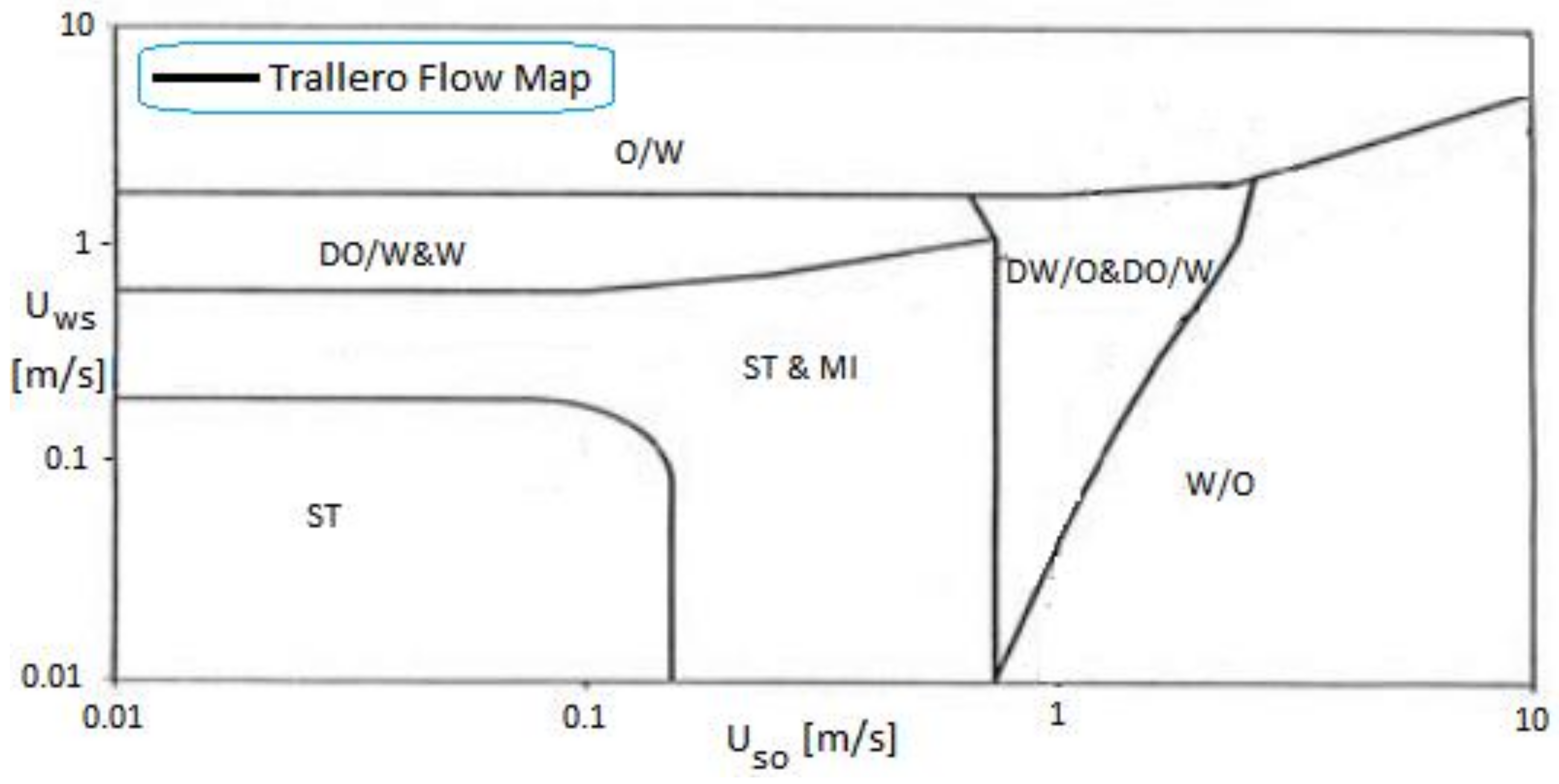
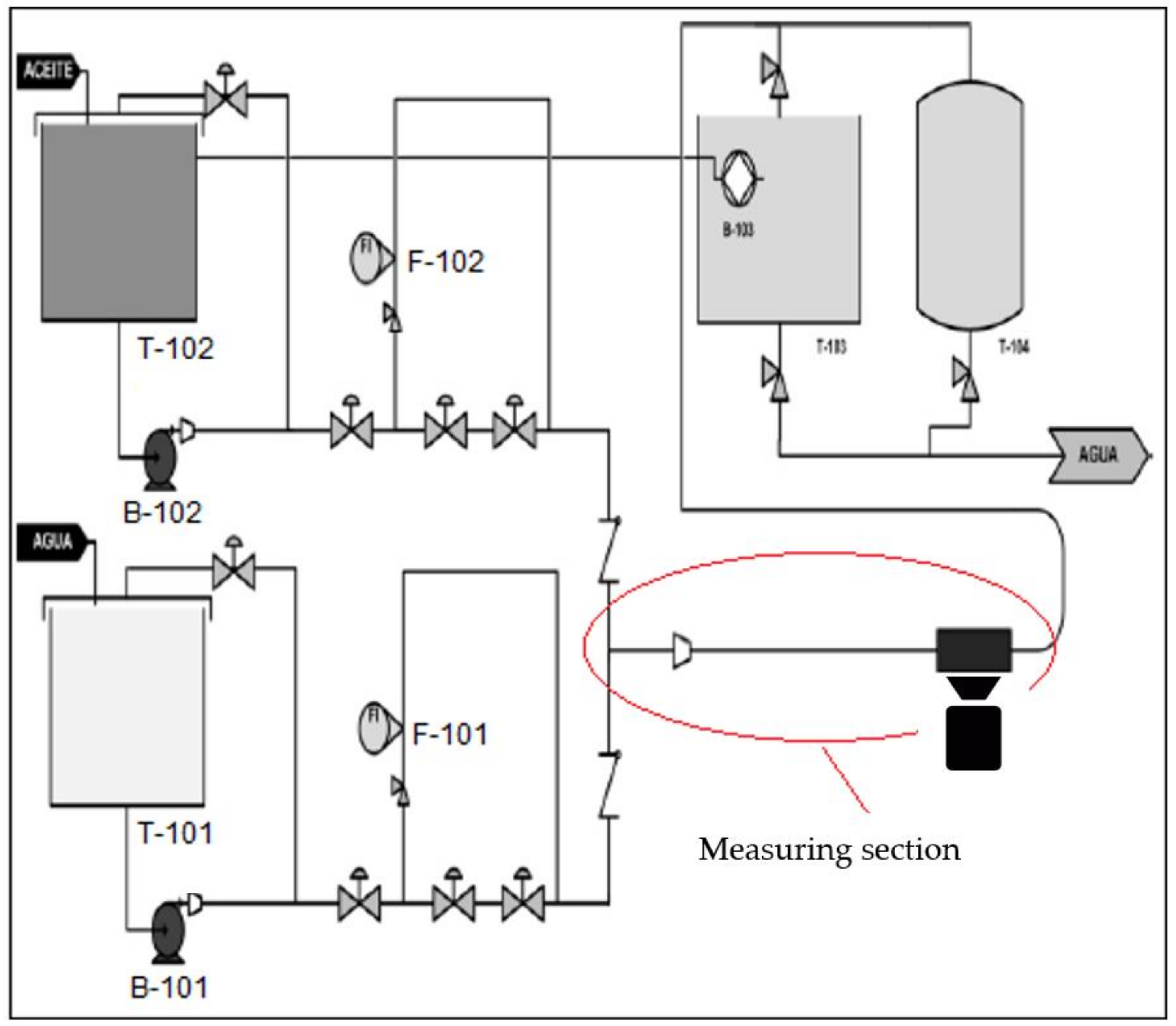
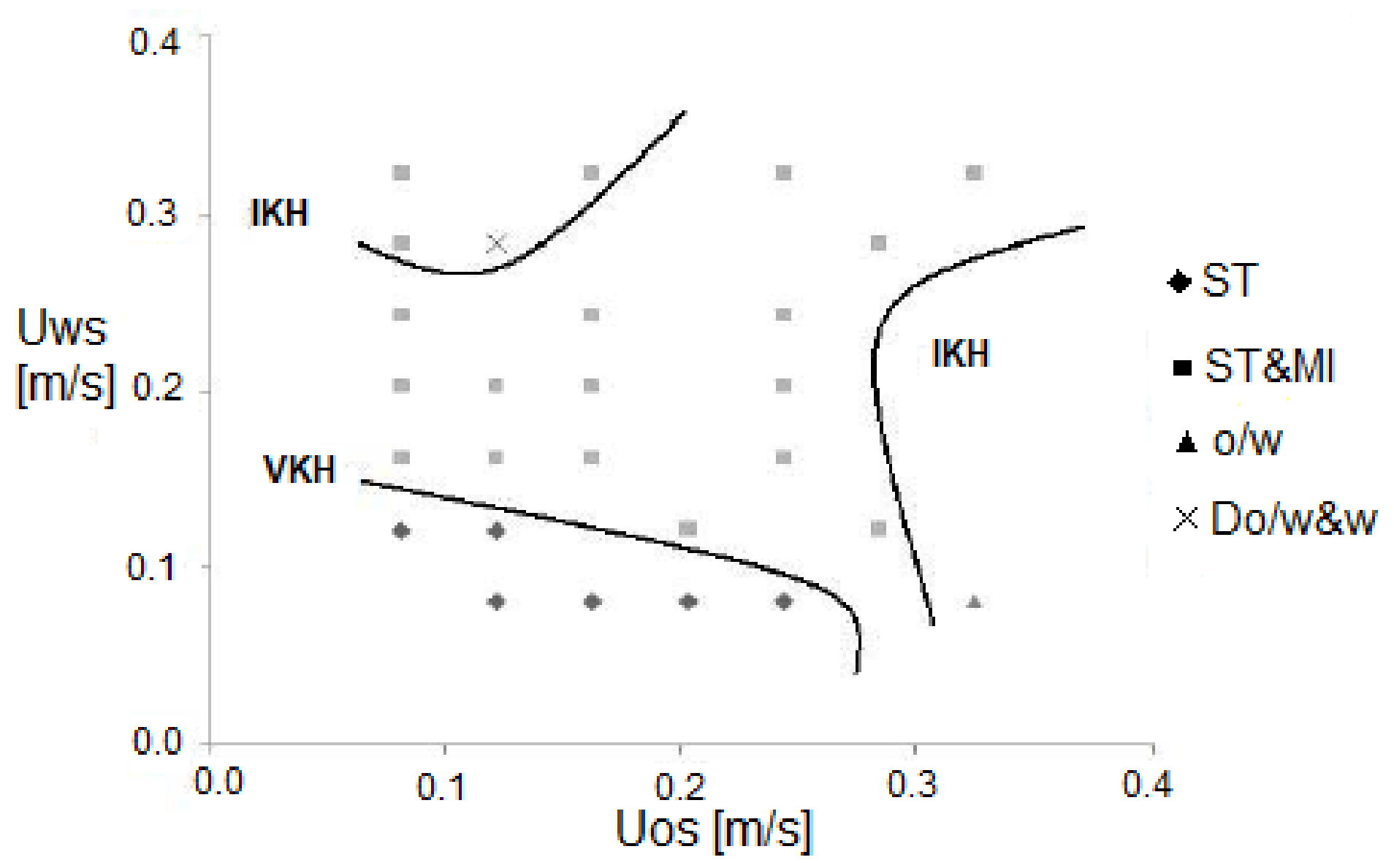




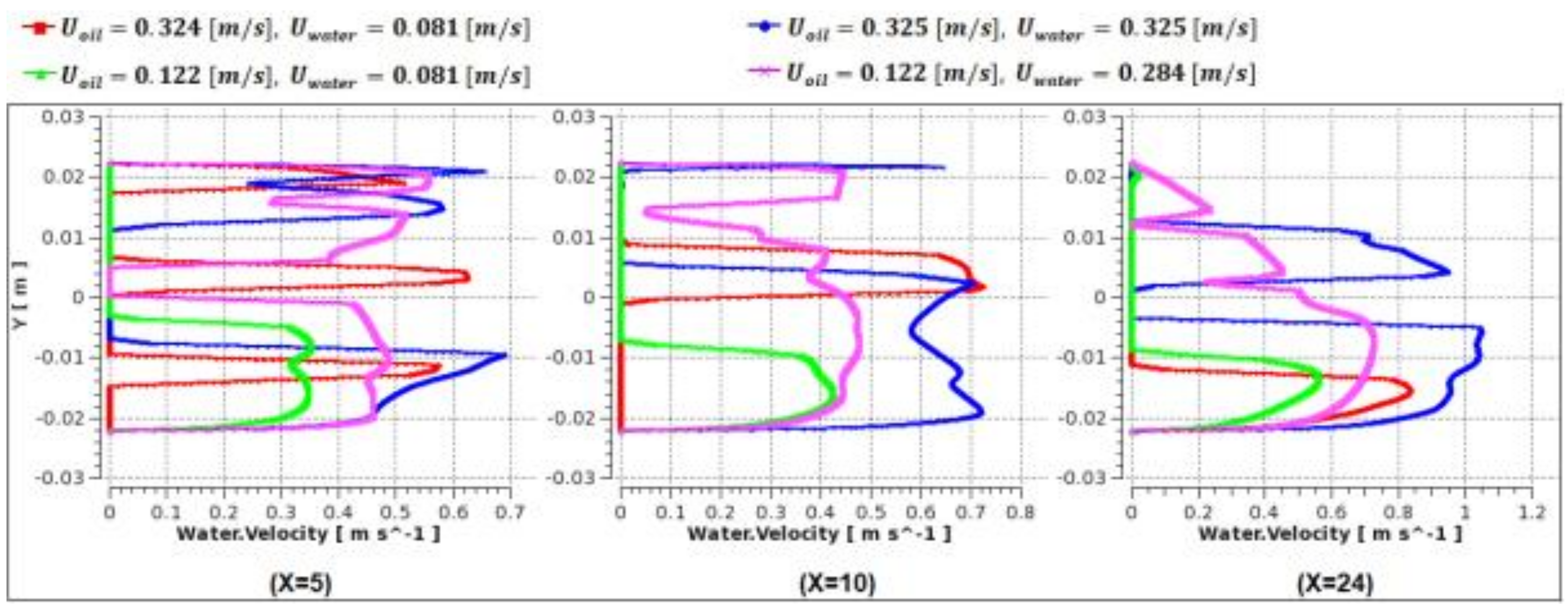
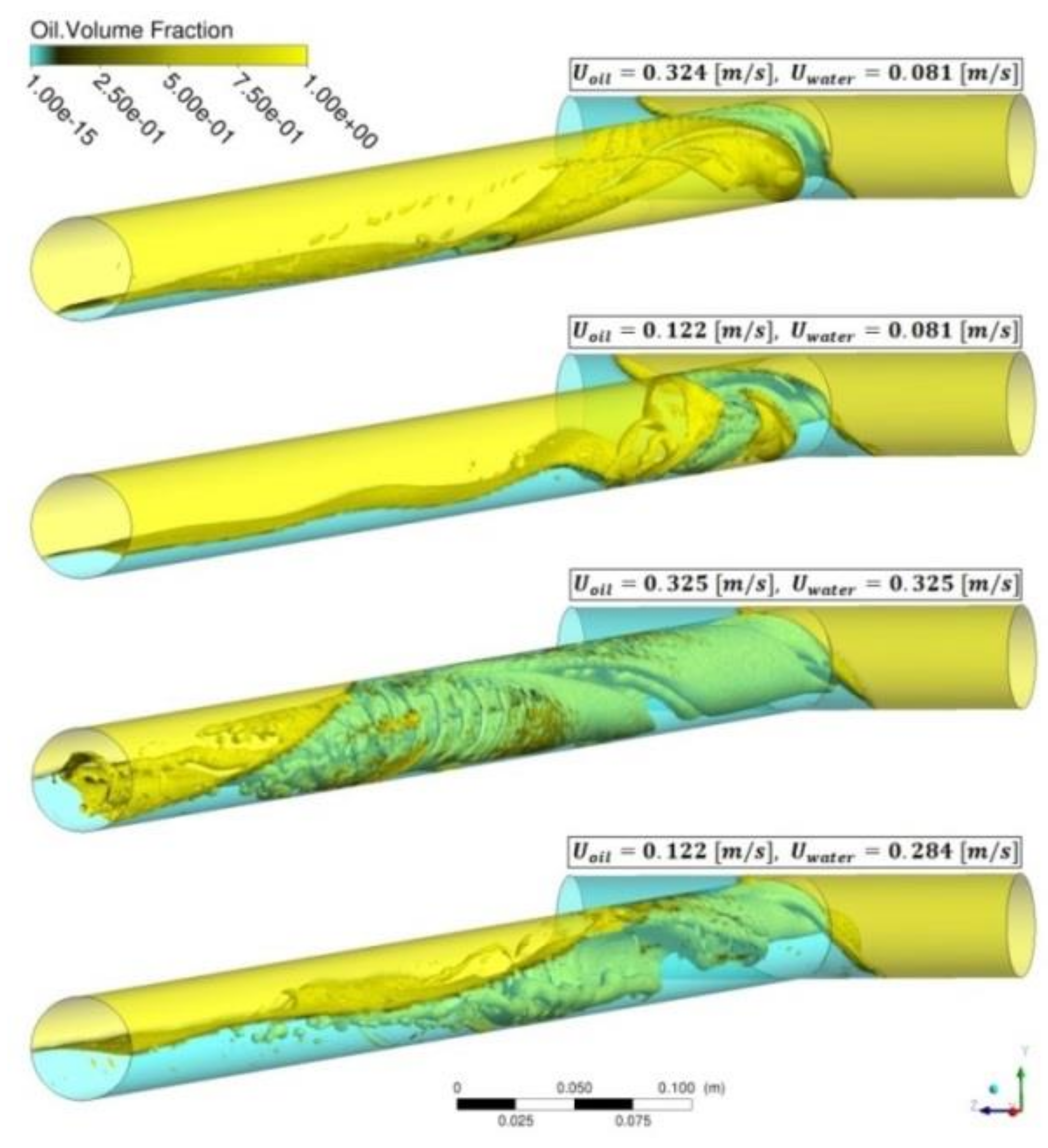
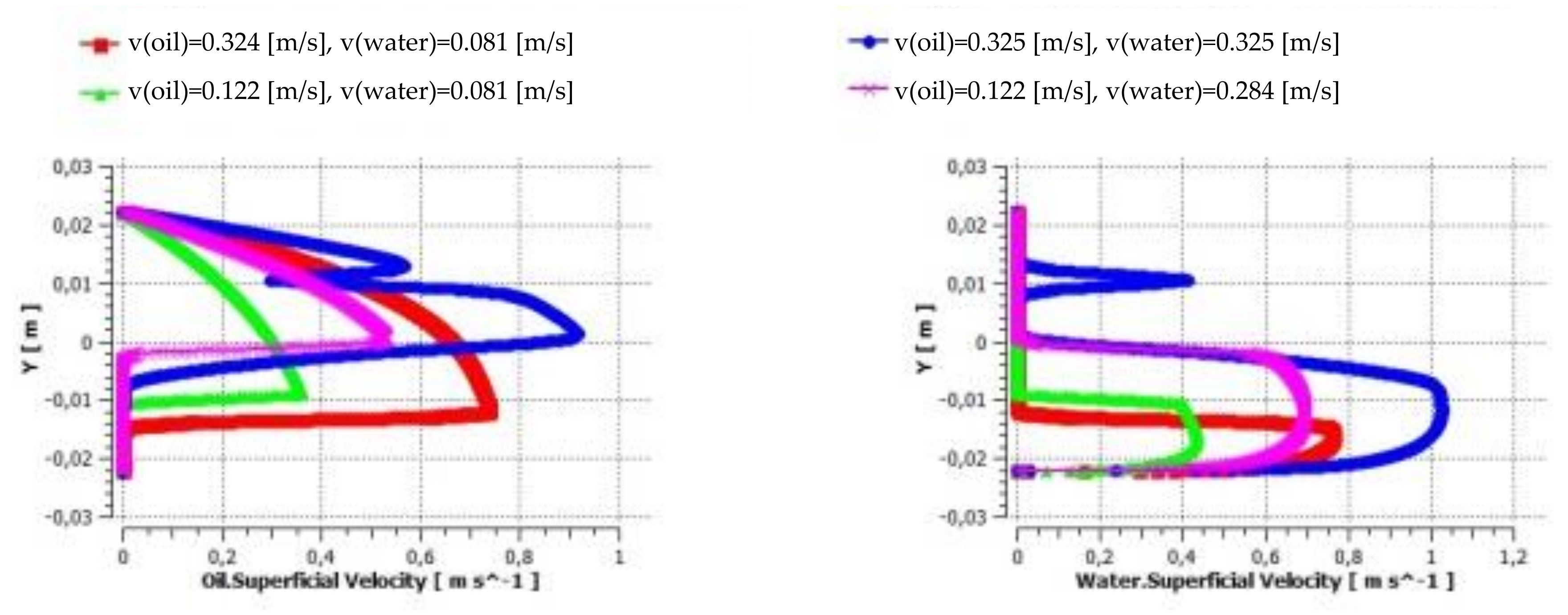
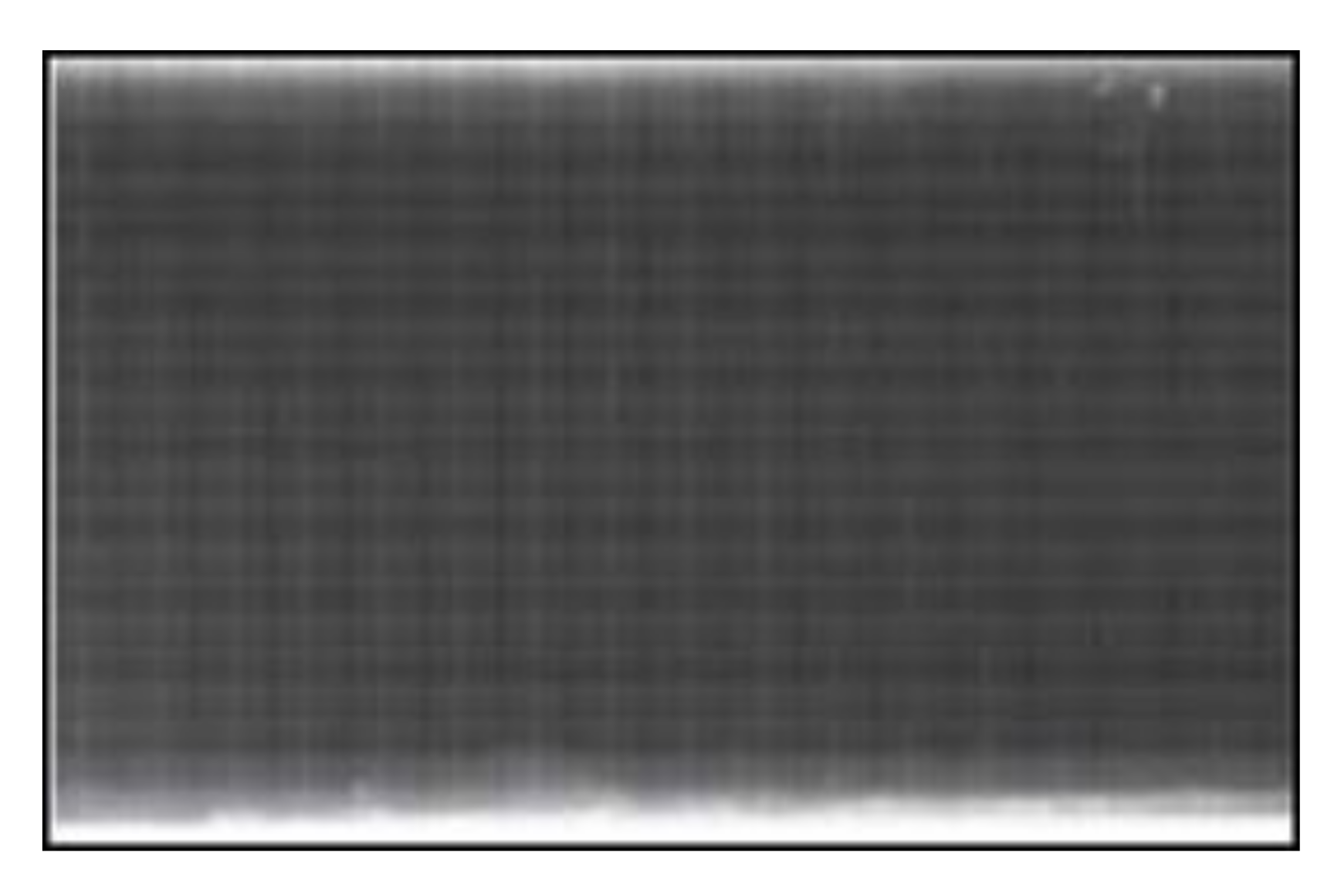
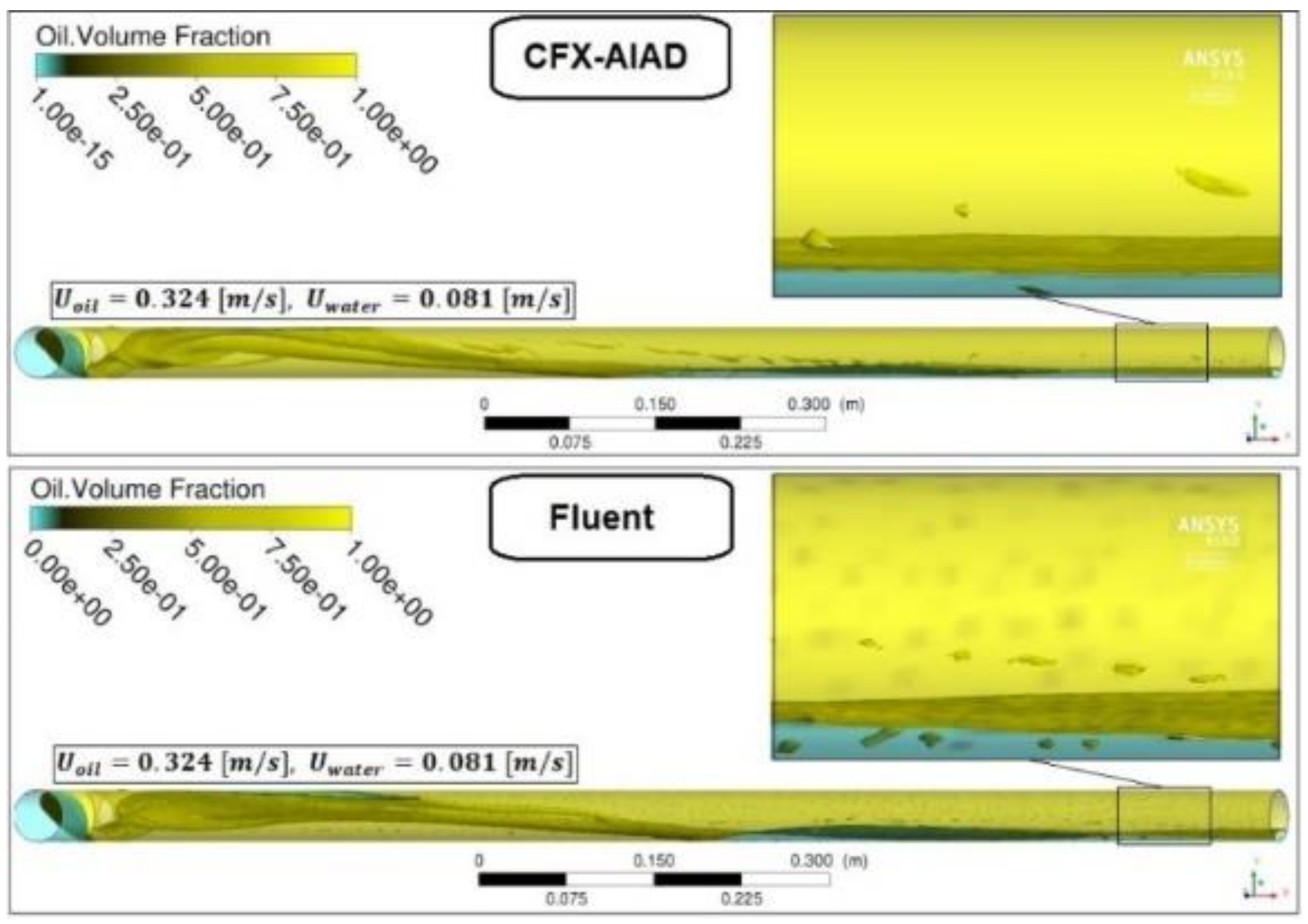

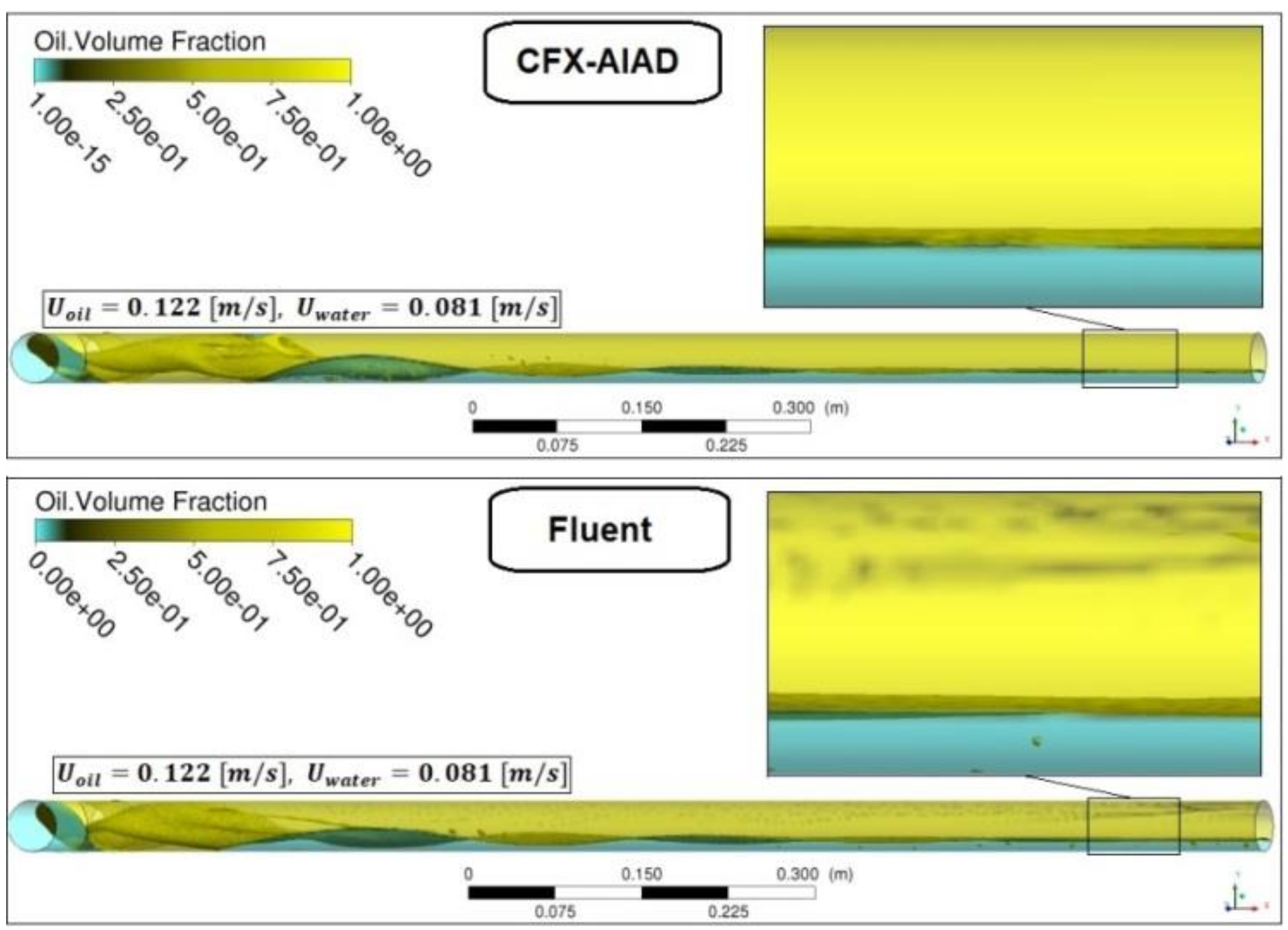
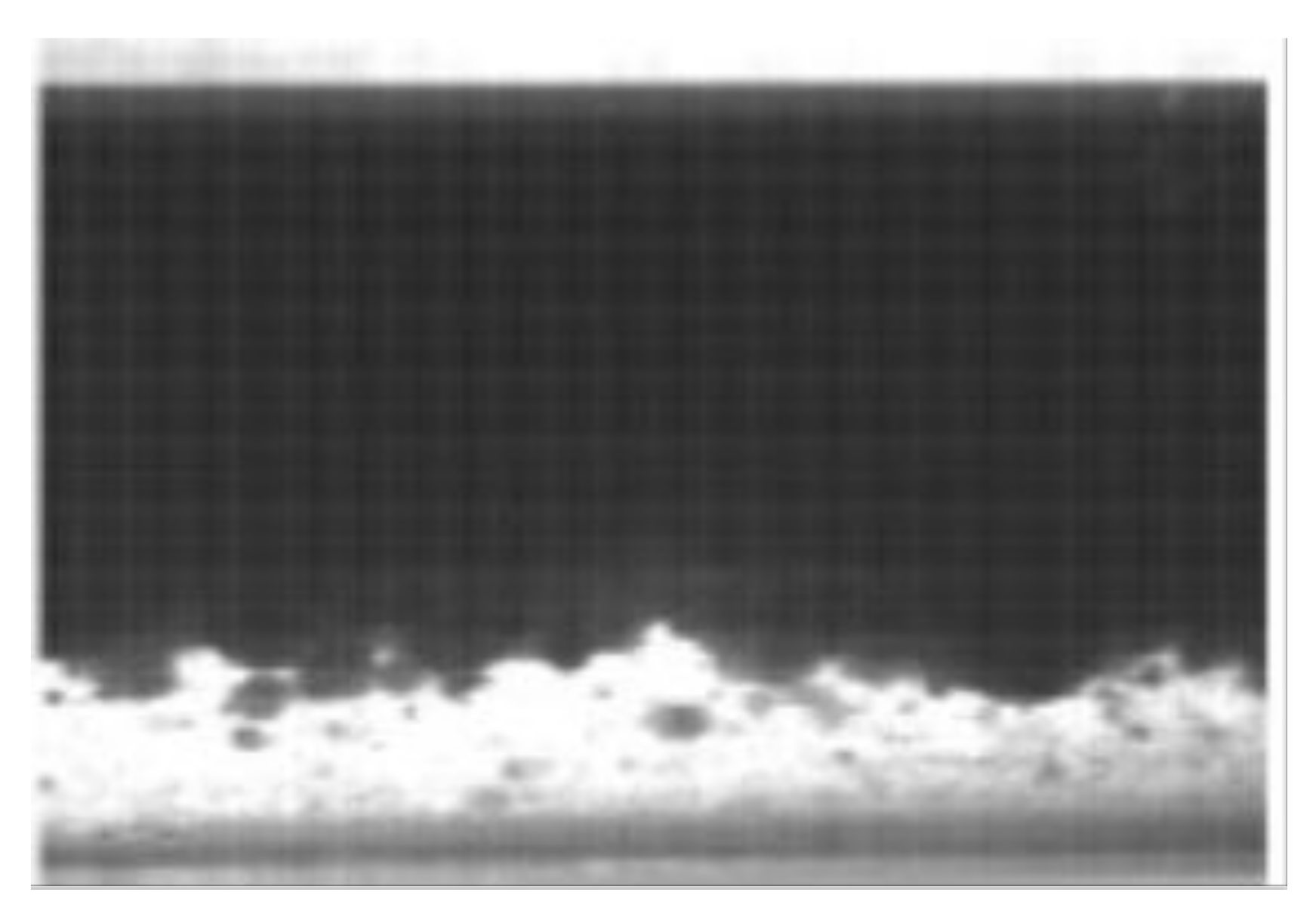
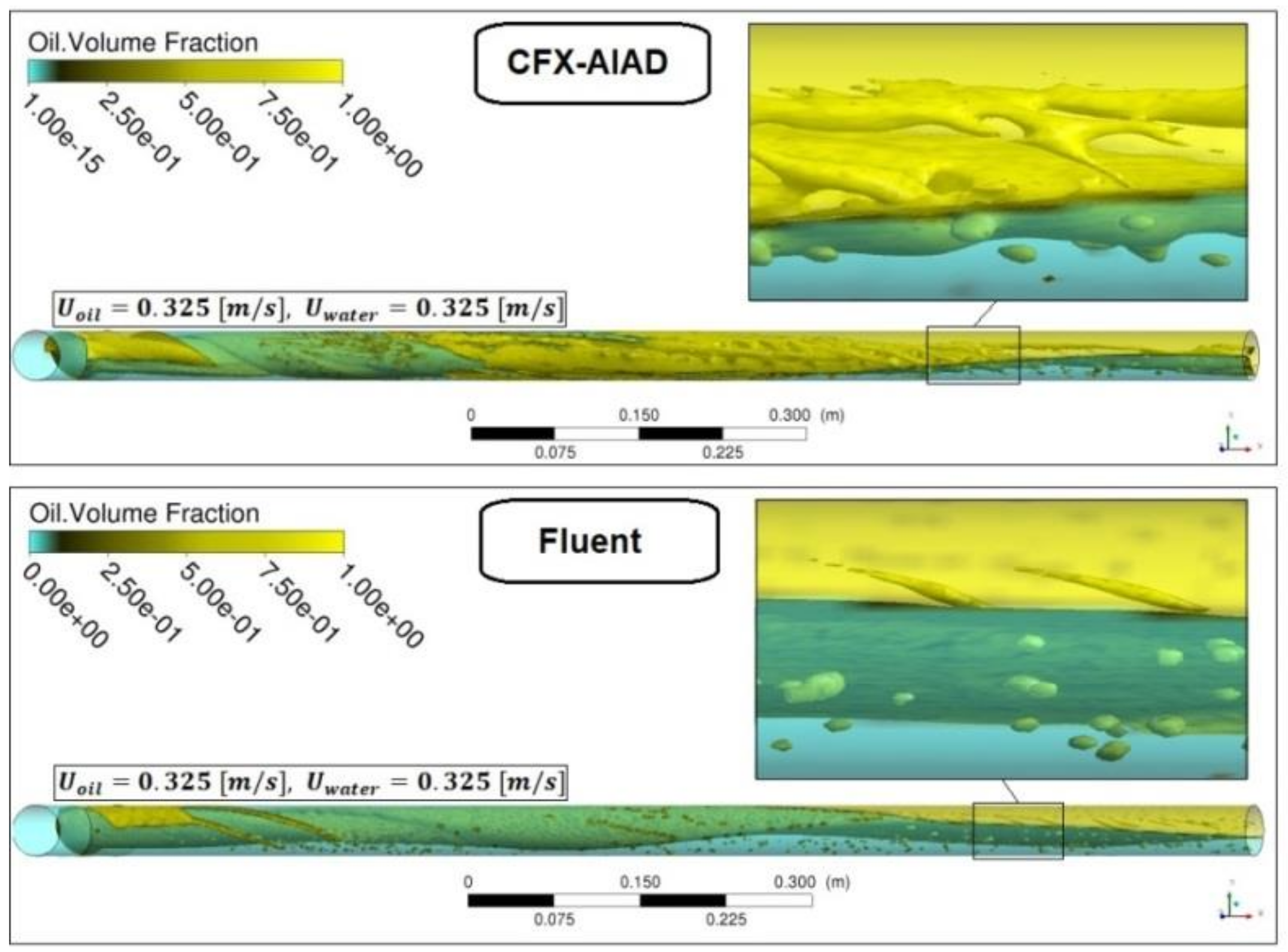


| Experiments | Oil Velocity (m/s) | Water Velocity (m/s) |
|---|---|---|
| 1. Case | 0.324 | 0.081 |
| 2. Case | 0.122 | 0.081 |
| 3. Case | 0.325 | 0.325 |
| 4. Case | 0.122 | 0.284 |
| Number of Elements | Cell Size (mm) | Averaged Cell Size (mm) | Maximum Cell Size (mm) |
|---|---|---|---|
| 1,813,413 | 0.08 | 1 | 1.5 |
| Analysis Type | Models | Material | Time Duration (s) |
|---|---|---|---|
| Transient | Multiphase: Eulerian (Multi-Fluid VOF model) | Oil (Hidrovenoco S-100) Water (Liquid) | Total Time 20 (s) |
| Viscous: k-ω-SST | |||
| Turbulence Multiphase: Mixture | |||
| Drag: Symmetric |
| Analysis Type | Models | Material | Time Duration (s) |
|---|---|---|---|
| Transient | Multiphase: Eulerian (Interface Model) | Oil (Hidrovenoco S-100) Water (Liquid) | Total Time 20 (s) |
| Turbulence Model: SST | |||
| Interface Transfer: Mixture Model | |||
| Momentum Transfer: AIAD |
| Oil | Water | |
|---|---|---|
| Morphology | Continuous fluid | Continuous fluid |
| Turbulence Damping | AIAD | AIAD |
| Sub-grid wave turbulence | AIAD | AIAD |
© 2020 by the authors. Licensee MDPI, Basel, Switzerland. This article is an open access article distributed under the terms and conditions of the Creative Commons Attribution (CC BY) license (http://creativecommons.org/licenses/by/4.0/).
Share and Cite
Höhne, T.; Rayya, A.; Montoya, G. Numerical Modelling of Horizontal Oil-Water Pipe Flow. Energies 2020, 13, 5042. https://doi.org/10.3390/en13195042
Höhne T, Rayya A, Montoya G. Numerical Modelling of Horizontal Oil-Water Pipe Flow. Energies. 2020; 13(19):5042. https://doi.org/10.3390/en13195042
Chicago/Turabian StyleHöhne, Thomas, Ali Rayya, and Gustavo Montoya. 2020. "Numerical Modelling of Horizontal Oil-Water Pipe Flow" Energies 13, no. 19: 5042. https://doi.org/10.3390/en13195042
APA StyleHöhne, T., Rayya, A., & Montoya, G. (2020). Numerical Modelling of Horizontal Oil-Water Pipe Flow. Energies, 13(19), 5042. https://doi.org/10.3390/en13195042






